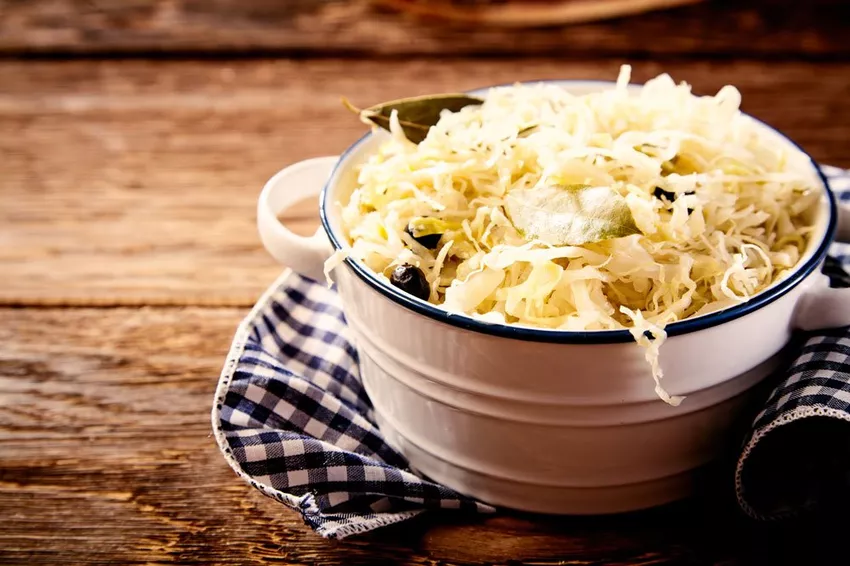If you make your own sauerkraut, you save money and can also determine the aroma yourself. We'll show you what you need.

While we tend to prefer light meals in summer, more hearty dishes are served in the cold season. Eisbein, Kassler and bratwurst are just three examples whose taste is perfectly rounded off with sauerkraut. It doesn't always have to be the finished sauerkraut from the jar. How about homemade sauerkraut? The production is not as complicated as you might think. You can also determine the taste yourself by adding various spices.
The right vessel
In order for the sauerkraut to ripen properly, you need a special container. A so-called fermentation pot is usually used for this. It is also known as a cabbage pot or cabbage barrel. Mason jars are also suitable as an alternative. However, the fermentation pot has the best prerequisites for preparing sauerkraut.
Additional accessories required:
- Herb masher
- weight stones
- clean cloth
Before preparation, it is important that the fermentation pot is rinsed out with hot water and then left to dry.
Preparing the cabbage
 The amount of cabbage depends on the size of the fermentation pot. As a guide, a ten liter pot will hold about eight kilograms of cabbage.
The amount of cabbage depends on the size of the fermentation pot. As a guide, a ten liter pot will hold about eight kilograms of cabbage.
The following recipe is designed for four kilograms of white cabbage. It is best to proceed as follows:
| Step | Explanation |
|---|---|
| Step 1 | First quarter the heads of cabbage and remove the stalk and the outer leaves. |
| Step 2 | The vegetables are now sliced into fine strips. This works best with a cabbage slicer or a large, sharp knife. |
| Step 3 | The fermentation pot is now lined with two to three cabbage leaves and then filled with cabbage to a height of about five centimetres. Spread about one to two teaspoons of s alt on top. |
| Step 4 | Use the cabbage masher to process the cabbage in the pot until liquid is visible. |
| Step 5 | Now repeat this process layer by layer until the pot is about 4/5 full. |
| Step 6 | Cover the top layer with the outer leaves of the cabbage and the lid and cover with the clean cloth. Then place the weighting stones on top. |
| Step 7 | The water channel integrated in the fermentation pot is now filled with s alt water. |
| Step 8 | The fermentation pot must now be left at room temperature for ten days to start the fermentation process. |
| Step 9 | Once the fermentation process has started, the pot is moved to the basement and remains there for about six weeks until the sauerkraut is ready. |
What s alt do you use?
The question of which s alt to use is primarily a matter of taste. However, there are gourmets who like to use sea s alt or rock s alt instead of normal kitchen s alt.
Lately, more and more users are putting algae between the individual layers. These also contain s alt and pass this on to the herb. In general, however, it can be said that normal, iodized and floured s alt can also be used.
Tip: Use a little less s alt the first time, as it can quickly be too much.
What spices can you use to refine sauerkraut?
 In addition to s alt, only a few spices are usually added when preparing sauerkraut. However, typical for the refinement are:
In addition to s alt, only a few spices are usually added when preparing sauerkraut. However, typical for the refinement are:
- Caraway
- Juniper berries
- Bay Leaves
- Orange, tangerine or pineapple pieces
- Onions
- Garlic
- Nutmeg
- Grapes
- Mustard Seeds
Tip: Some also like to add beer, wine, apple juice, vinegar or lemon juice as an additional liquid. The latter two are mainly used for additional acidification.
A Note on Relocation
When moving to the cellar, strong temperature fluctuations can result in a vacuum being created inside the pot and liquid being sucked out of the fermentation channel into the pot. This will spoil the herb and should be avoided.
Therefore, when moving, it is advisable to gradually adjust the temperature if it is between the twostorage locations varies too much.